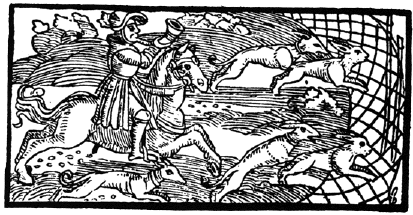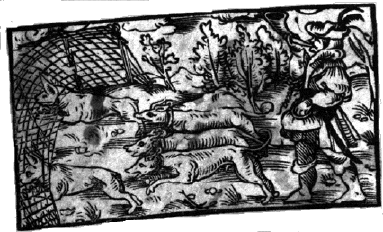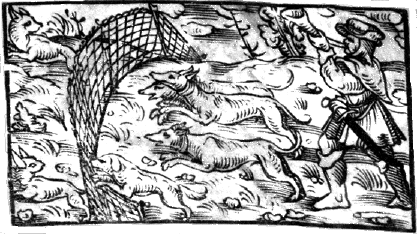
There is a mnemonic to help remember the sequence of events when the Pesach Seder is held on Saturday night: YaKNeHaZ
The mnemonic YaKNeHaZ sounds somewhat similar to a German expression (jag den Has) which means "hunt the hare" and for this reason, some medieval haggadot were decorated with a picture of a rabbit-hunting scene.
Here is an example from a haggadah published in Prague in 1526:

Commentary by Rabbi Fred Davidow: The scene is an allegory. Our history is the history of an escaped people. In the Augsburg Haggadah of 1534 there are two scenes of Jagen-has. The first shows the hare being hotly pursued by dogs and a hunter. The hare is being chased toward a net and the outcome seems that the hare will be caught in the net and then savagely attacked.

In the second scene, at the last moment, the net miraculously lifts up, the hare goes through and with legendary speed, it outruns the dogs. (Thank goodness this hare did not look back and see that the dogs were slower and take a rest by the side of the road.) The hare as a symbol of the Jewish people in Haggadah illustrations has an interesting parallel in B'rer Rabbit of the Uncle Remus tales, who always manages by quick wits to thwart the designs of B'rer Fox and B'rer Bear to have him for supper. B'rer Rabbit can be interpreted as a symbolic representation of Negro slaves, who pictured themselves as outsmarting their white slavemasters. Jews could see themselves in Europe as rabbits that needed speed and agility (in Jewish terms, quick wits and/or stratagems) to avoid, as best as possible, anti-Semitic plans for their destruction. The Golem is a fantasy in the same vein. Eve Bunting wrote an allegorical children's story about the Holocaust, "Terrible Things," and it is Little Rabbit who survives. As for the rabbit being non-kosher, so is the lion, as in the Lion of Judah, which conveys a completely different image of the Jew from that of the hare.

Commentary by Rabbi Bernard Mehlman: The presence of the two plates for the first time in the Augsburg Haggadah may be an allegory on the fate of the Jews often persecuted at the Pesach/Easter season.
Commentary by Rabbi Amy Scheinerman: Rabbi Davidow's sense that the hunting scene is an allegory for Jewish history reminds me of the interpretation of Chad Gadya as an allegory of Jewish history. Moreover, the success of the hares in escaping their would-be captors reminds one of the sense of jubilation our ancestors must have felt after crossing through the Reed Sea and seeing their oppressors permanently separated from them and unable to reach them. The net renders the dogs and hunters unable to reach the hares. They look back and sing their own version of Shirat HaYam.
For more images, click here to see the Hebrew Union College - Jewish Institute of Religion Klau Library site Haggadah images.